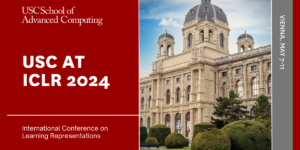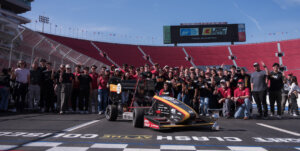
Hollenbeck Middle School student intently concentrating on his code. Photo by Nick Nuccio.
As the sounds of muffled pop music mixed with children’s laughter in Ronald Tutor Hall, a confused passersby could reasonably assume that a birthday party was taking place. They might even have entered the room and glanced at the source of the chaos — rambunctious middle schoolers giggling and pointing at animated animals dancing on their computer screens — and concluded the kids were just playing video games.
What they might never guess is that these middle schoolers were actually learning the fundamentals of computer programming.
This particular bunch of enthusiastic children came from Hollenbeck Middle School in Boyle Heights to the USC Viterbi School of Engineering to participate in the Hour of Code, a global initiative during 2019 Computer Science Education Week.
The USC Viterbi events over December 9-10, dubbed “Code Dojo,” invited local middle and high school to spark their interest in the world of coding.
Instead of sitting in a classroom learning about algorithm design and control structures like their college-age counterparts, the aspiring programmers learned basic principles through an interactive challenge called Dance Party, using the website code.org. The dance party exercise utilized a system called “block coding” where beginners do not actually have to type out each line of code but can instead select from a given list of pre-written partial codes. This makes it easier to learn the structure of programming without getting stuck in the details of the syntax.
“A lot of kids have the potential to learn to code and should be encouraged to pursue it.”
Abby Nguyen
A USC Viterbi student organization, Robogals, volunteered to guide the Hollenbeck students through the activity. The Robogals frequently partner with local schools to inspire young girls and other minorities to study engineering.
Susan Chavez, a sophomore studying business administration with a minor in computer programming, gushed about the opportunity to work with these kids: “The impact that coding activities have on the kids is so meaningful because exposing them to coding early on could influence their decision to pursue a STEM career,” she explains. “It is especially important to work with local schools because there is a lack of underrepresented students in STEM.”
The Robogals helped the kids flex their creative sides by teaching a coding function called “loops,” which make a set of code run multiple times. The students used the concepts they learned to animate various characters — from a moose to an alien — to dance along to a beat.
“All the kids picked up the program really quickly,” commented Abby Nguyen, a sophomore studying chemical engineering. “A lot of kids have the potential to learn to code and should be encouraged to pursue it.”

Robogal Nikki Liu helps a Hollenbeck student code his dance party. Photo by Nick Nuccio.
In addition to the students from Hollenbeck, the Code Dojo event serviced multiple local schools including Florence Nightingale Middle School, Mulholland Middle School, and Theodore Roosevelt High School. Assisting these rookie coders were USC students from the Institute of Electrical and Electronics Engineers (IEEE) club, as well as seven professional computer scientists from Cox Automotive.
This is the second year that Cox has partnered with the USC Viterbi K-12 STEM Center for their CS Ed Week events. In addition to showing the kids various art-based coding exercises, the Cox engineers spoke about their experiences utilizing coding techniques in the workplace.
“Industry professionals who volunteer bring a vision of a career — not just college — and speak about the benefits and challenges of working in computer science,” said Katie Mills, co-director of the K-12 STEM Center.
USC Viterbi’s Code Dojo event has occurred annually since 2014, helping introduce thousands of underrepresented students to computer science.
“Hour of Code is a compelling way to bring attention to computer science and help children get over their fear of coding,” Mills said. “The kids walk out of our event realizing that coding is actually quite fun.”
Published on December 17th, 2019
Last updated on May 16th, 2024











